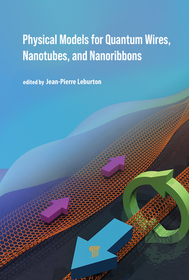
Physical Models for Quantum Wires, Nanotubes, and Nanoribbons
-
10% KEDVEZMÉNY?
- A kedvezmény csak az 'Értesítés a kedvenc témákról' hírlevelünk címzettjeinek rendeléseire érvényes.
- Kiadói listaár GBP 270.00
-
128 992 Ft (122 850 Ft + 5% áfa)
Az ár azért becsült, mert a rendelés pillanatában nem lehet pontosan tudni, hogy a beérkezéskor milyen lesz a forint árfolyama az adott termék eredeti devizájához képest. Ha a forint romlana, kissé többet, ha javulna, kissé kevesebbet kell majd fizetnie.
- Kedvezmény(ek) 10% (cc. 12 899 Ft off)
- Kedvezményes ár 116 093 Ft (110 565 Ft + 5% áfa)
Iratkozzon fel most és részesüljön kedvezőbb árainkból!
Feliratkozom
128 992 Ft

Beszerezhetőség
Becsült beszerzési idő: A Prosperónál jelenleg nincsen raktáron, de a kiadónál igen. Beszerzés kb. 3-5 hét..
A Prosperónál jelenleg nincsen raktáron.
Why don't you give exact delivery time?
A beszerzés időigényét az eddigi tapasztalatokra alapozva adjuk meg. Azért becsült, mert a terméket külföldről hozzuk be, így a kiadó kiszolgálásának pillanatnyi gyorsaságától is függ. A megadottnál gyorsabb és lassabb szállítás is elképzelhető, de mindent megteszünk, hogy Ön a lehető leghamarabb jusson hozzá a termékhez.
A termék adatai:
- Kiadás sorszáma 1
- Kiadó Jenny Stanford Publishing
- Megjelenés dátuma 2023. augusztus 31.
- ISBN 9789814877916
- Kötéstípus Keménykötés
- Terjedelem570 oldal
- Méret 229x152 mm
- Súly 453 g
- Nyelv angol
- Illusztrációk 138 Illustrations, black & white; 33 Illustrations, color; 13 Tables, black & white 492
Kategóriák
Rövid leírás:
This book is a compilation of articles that span more than 30 years of research on developing comprehensive physical models that describe the physical properties of quantum wires.
TöbbHosszú leírás:
Quantum wires are artificial structures characterized by nanoscale cross sections that contain charged particles moving along a single degree of freedom. With electronic motions constrained into standing modes along with the two other spatial directions, they have been primarily investigated for their unidimensional dynamics of quantum-confined charge carriers, which eventually led to broad applications in large-scale nanoelectronics. This book is a compilation of articles that span more than 30 years of research on developing comprehensive physical models that describe the physical properties of these unidimensional semiconductor structures. The articles address the effect of quantum confinement on lattice vibrations, carrier scattering rates, and charge transport as well as present practical examples of solutions to the Boltzmann equation by analytical techniques and by numerical simulations such as the Monte Carlo method. The book also presents topics on quantum transport and spin effects in unidimensional molecular structures such as carbon nanotubes and graphene nanoribbons in terms of non-equilibrium Green?s function approaches and density functional theory.
TöbbTartalomjegyzék:
Part I: Semiconductor Quantum Wires 1. Size Effects on Polar Optical Phonon Scattering of One-Dimensional and Two-Dimensional Electron Gas in Synthetic Semiconductors 2. Self-Consistent Polaron Scattering Rates in Quasi-One-Dimensional Structures3. Plasmon Dispersion Relation of a Quasi-One-Dimensional Electron Gas 4. Size Effects in Multisubband Quantum Wire Structures 5. Impurity Scattering with Semiclassical Screening in Multiband Quasi-One-Dimensional Systems 6. Resonant Intersubband Optic Phonon Scattering in Quasi-One-Dimensional Structures 7. Intersubband Population Inversion in Quantum Wire Structures 8. Intersubband Resonant Effects of Dissipative Transport in Quantum Wires 9. Intersubband Optic Phonon Resonances in Electrostatically Confined Quantum Wires 10. Transient Simulation of Electron Emission from Quantum-Wire Structures 11. Carrier Capture in Cylindrical Quantum Wires 12. Electron-Phonon Interaction and Velocity Oscillations in Quantum Wire Structures 13. Transient and Steady-State Analysis of Electron Transport in One-Dimensional Coupled Quantum-Box Structures 14. Acoustic-Phonon Limited Mobility in Periodically Modulated Quantum Wires 15. Antiresonant Hopping Conductance and Negative Magnetoresistance in Quantum-Box Superlattices 16. Oscillatory Level Broadening in Superlattice Magnetotransport 17. Breakdown of the Linear Approximation to the Boltzmann Transport Equation in Quasi-One-Dimensional Semiconductors 18. Optic-Phonon-Limited Transport and Anomalous Carrier Cooling in Quantum-Wire Structures 19. lntersubband Stimulated Emission and Optical Gain by ?Phonon Pumping? in Quantum Wires 20. Superlinear Electron Transport and Noise in Quantum Wires 21. Importance of Confined Longitudinal Optical Phonons in Intersubband and Backward Scattering in Rectangular AlGaAs/GaAs Quantum Wires 22. Confined and Interface Phonon Scattering in Finite Barrier GaAs/AlGaAs Quantum Wires 23. Hole Scattering by Confined Optical Phonons in Silicon Nanowires Part II: Carbon Nanotubes and Nanoribbons 24. Nonlinear Transport and Heat Dissipation in Metallic Carbon Nanotubes 25. Joule Heating Induced Negative Differential Resistance in Freestanding Metallic Carbon Nanotubes 26. Restricted Wiedemann?Franz Law and Vanishing Thermoelectric Power in One-Dimensional Conductors 27. High-Field Electrothermal Transport in Metallic Carbon Nanotubes 28. Atomic Vacancy Defects in the Electronic Properties of Semi-metallic Carbon Nanotubes 29. Chirality Effects in Atomic Vacancy?Limited Transport in Metallic Carbon Nanotubes 30. Vacancy Cluster?Limited Electronic Transport in Metallic Carbon Nanotubes 31. Vacancy-Induced Intramolecular Junctions and Quantum Transport in Metallic Carbon Nanotubes 32. On the Sensing Mechanism in Carbon Nanotube Chemiresistors 33. Defect Symmetry Influence on Electronic Transport of Zigzag Nanoribbons 34. Controllable Tuning of the Electronic Transport in Pre-designed Graphene Nanoribbon 35. Quantum Conduction through Double-Bend Electron Waveguide Structures 36. Quantum Ballistic Transport through a Double-Bend Waveguide Structure: Effects of Disorder 37. Quantum Transport through One-Dimensional Double-Quantum-Well Systems 38. Cascaded Spintronic Logic with Low-Dimensional Carbon
Több



